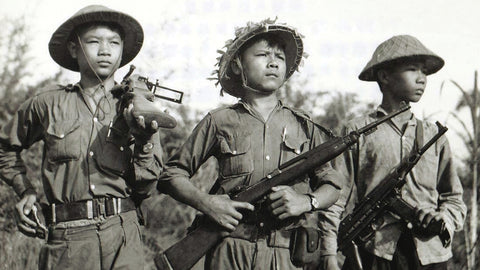
Here Are the Weapons of the NVA — Backed by Russia and China
Vietnam has fought numerous invasions over the past two millennia, usually against China or whoever happened to have conquered China, including the formidable, ruthless Mongols. Whenever they could not defeat **** the invaders, the Vietnamese armed forces eventually wore them down by simply refusing to quit.
When the United States involved itself in bolstering the South Vietnamese government against the insurgent communist Viet Cong, it did so with the expectation of crushing a guerrilla movement.
In November 1965, however, the U.S. 1st Cavalry Division (Airmobile) fought its first major battle against North Vietnamese Army regulars, who had been infiltrating the South via the Ho Chi Minh Trail snaking along the Laotian and Cambodian borders since the early 1960s. The communists also made extensive use of South Vietnam’s rivers and, to a lesser extent, the east coast, to smuggle supplies in .
TOP: Inspired by the German
Sturmgewehr 44 of World War II but redesigned and simplified in 1947 by
Mikhail Kalashnikov, the AK-47 assault rifle was easy to maintain and operate
under extreme conditions. A staple of the North Vietnamese Army, it was also
the weapon of choice for some U.S. special operations teams. ABOVE: Soviet
designer Semyon Simonov’s SKS carbine was outclassed by the AK-47 but made a
reliable supplement in NVA units. (Jeff Workman/Dreamstime; Martin
Brayley/Dreamstime)
Soldiers of the National
Liberation Front , the Viet Cong, in the early 1960s display weapons from a
variety of sources, from left, a captured American M79 grenade launcher; an
American M1 carbine, captured from the French or South Vietnamese or supplied
by the Chinese; and a K-50M submachine gun supplied by North Vietnam.
(Sovfoto)
North Vietnam’s home-
manufactured K-50M incorporated selected components from the Soviet PPSh-41
and the French MAT-49 submachine guns. (Greg Proch)
Similar to but simpler than the Browning M1911 automatic
pistol, Fedor Tokarev’s TT-33 was adopted in 1931, and 1,330,000 were made in
the Soviet Union alone by 1952. It and the license-produced K54 were standard
NVA officer sidearms. (World of Triss/Alamy)
The NVA’s
principal squad machine gun for most of the war, the RPD Model 44 was much
lighter than the American M60, but its barrel could not be changed,
necessitating short bursts to avoid overheating. (Jose Marafona/Dreamstime)
Viet Cong troops fire a 12.7 mm DShK
machine gun at U.S. aircraft during an air raid on a South Vietnamese village.
An essential element in NVA and VC air defense, the DShK was dreaded among
Americans as the “.51-caliber” and the “eater of helicopters.” (Central
Press/Getty Images)
Displayed is a cache of communist grenades, mostly
Chinese Type 67s, captured by a U.S. Marine after an ambush in Cam Hieu
village, Quang Tri province, in northern South Vietnam on Dec. 4, 1967.
Although deadly within a 6-foot radius, Chicom—short for Chinese
communist—grenades suffered from a high percentage of duds. (Ed Palm
Photo/Getty Images)
North Vietnamese troops support an assault with an M-43
120 mm mortar. (Texas Tech University Vietnam Archive)
The ancient
art of planting punji stakes to disable enemy soldiers was revived by the VC
and taught to the NVA. (Rolls Press/Popperfoto via Getty Images)
The RPG-7
rocket-propelled grenade gave NVA troops an “equalizer” against American
armored vehicles…usually if they could get around to the side or rear.
(Sovfoto)
A
latecomer to the war, the Soviet PK machine gun was essentially a squad
machine gun based on the AK-47. Like the American M60’s barrel, the PK’s
barrel could be changed when it overheated. (Greg Proch)
The next decade would see both sides, the Americans/South Vietnamese and NVA/VC changing and adapting their tactics against each other. Essentially the NVA was a light infantry force backed by whatever heavier support it could field, adding guerrilla tactics learned from the VC to their repertoire.
Initially the VC used whatever French, American or other weaponry they could get their hands on, but with each infusion of NVA troops came a steady flow of Soviet and Chinese arms that made their infantry the equal of their opponents. Although the North Vietnamese did not commit any air support to their ground forces—which in any event would not have had a chance against the Americans—the NVA added more artillery, tanks and anti-aircraft weaponry to its forces between 1968 and 1975. In the end, in spite of the horrendous price they paid on the battlefield, what they had proved to be enough.
historynet magazines
Our 9 best-selling history titles feature in-depth storytelling and iconic imagery to engage and inform on the people, the wars, and the events that shaped America and the world.
